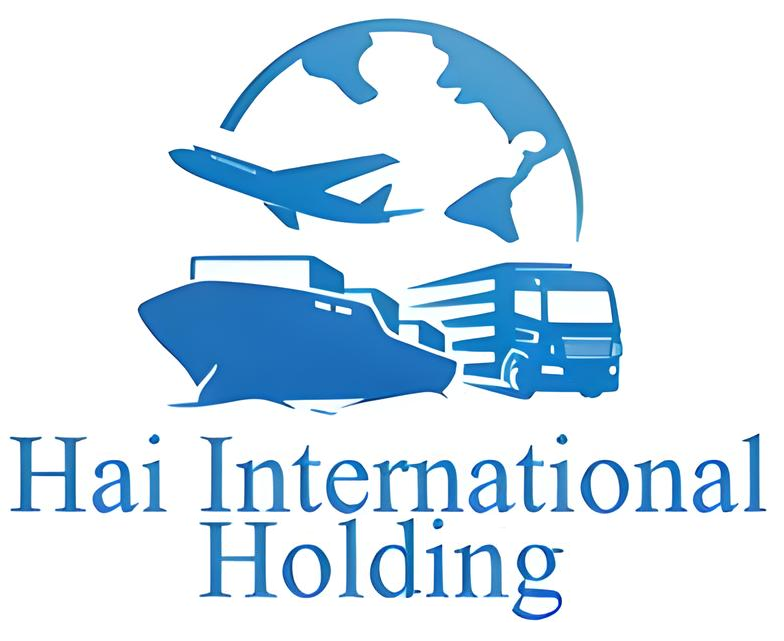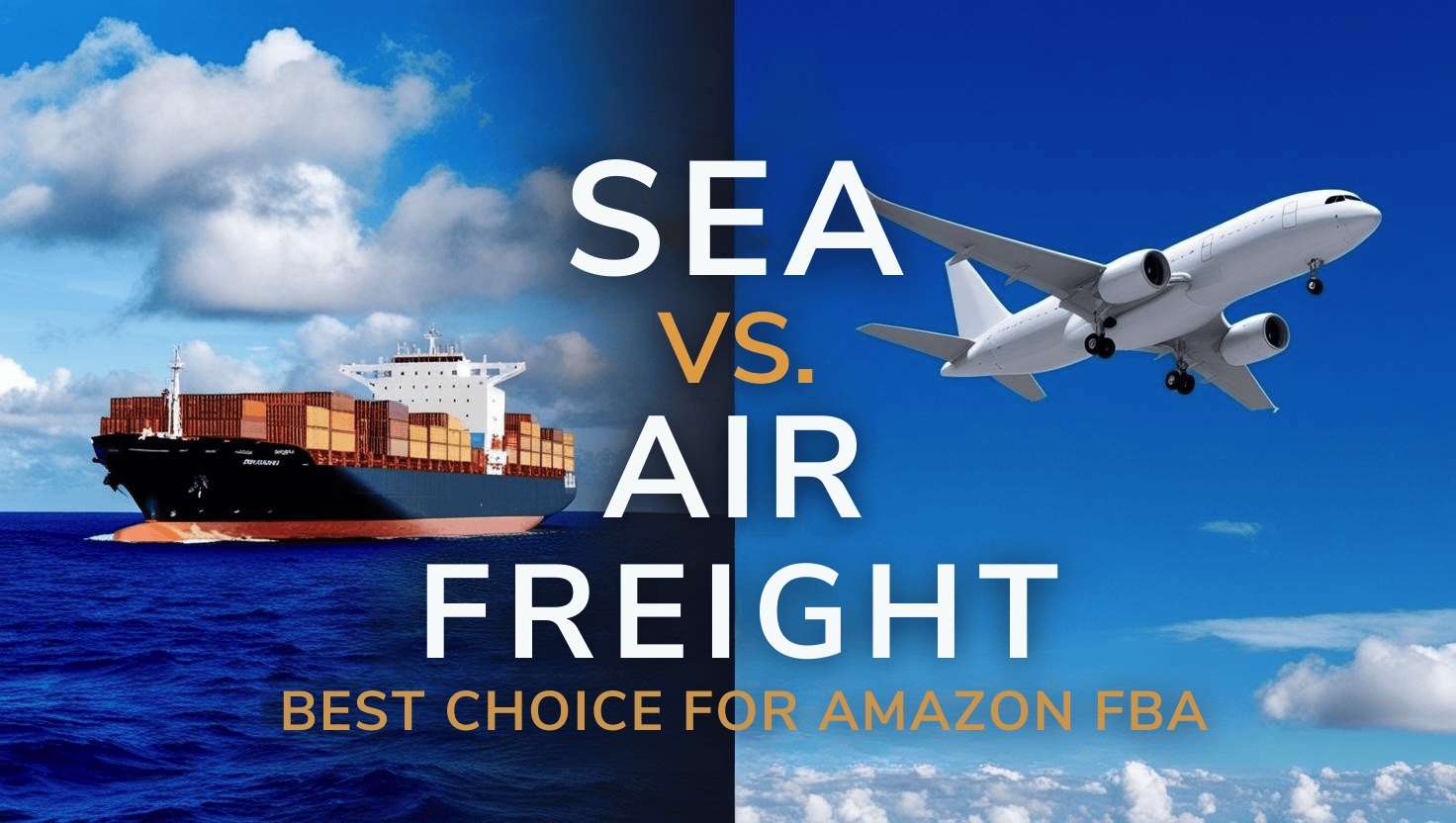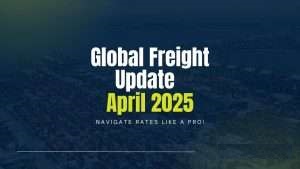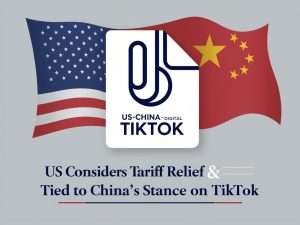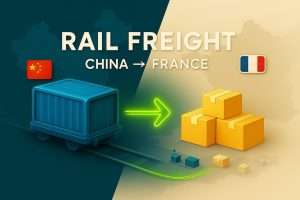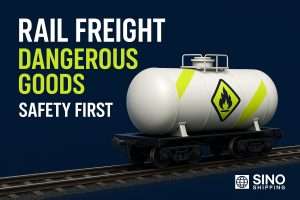Imagine this: You’re an Amazon FBA seller, and your best-selling product is flying off the shelves faster than expected. Your inventory in Amazon’s fulfillment center is running dangerously low. You didn’t anticipate such rapid sales, and now you’re faced with a critical decision—how to restock quickly without killing your profit margins.
Your supplier in China confirms they can produce a new batch within a week, but getting it to an Amazon FBA warehouse is another story. You have two main options:
- Air Freight: Fast but expensive. Your products could be back in stock within a week, but at 3 to 5 times the cost of sea freight.
- Sea Freight: Much cheaper, but slow. You’d save money on shipping, but waiting 30-40 days could mean missing out on peak sales, losing your Amazon ranking, and possibly seeing customers buy from competitors instead.
This is the core dilemma every Amazon FBA seller faces—balancing cost, speed, and inventory planning. Choose air freight, and you stay in stock but shrink your margins. Choose sea freight, and you maximize profits but risk losing momentum. So, which one should you pick?
In this article, we’ll break down both options with real-world insights, helping you make the right choice based on your business model, product type, and sales strategy. Let’s dive in. 🚀
1. The Reality of Sea and Air Freight for Amazon Sellers
When choosing between sea and air freight for Amazon FBA, it’s not just about cost and speed—it’s about how each shipping method aligns with your business model, product type, and cash flow. Let’s break down the two options in a way that makes it easier for you to decide.
A. How Sea Freight Actually Works
Sea freight is the backbone of global trade, moving over 80% of goods worldwide. For Amazon FBA sellers, it is the most cost-effective way to ship large quantities, but it requires patience and planning.
Who Should Use Sea Freight?
✅ Sellers shipping large quantities at once – If you’re moving high volumes, sea freight is the best way to reduce your cost per unit.
✅ Those who can afford longer transit times – If you have strong inventory forecasting, you can plan ahead and avoid the need for last-minute expensive air shipments.
✅ Private label brands with stable sales projections – If your product demand is predictable, bulk shipments by sea can save you thousands in logistics costs.
What to Expect with Sea Freight
- Transit time: 🕒 25-50 days (varies based on route, customs clearance, and port congestion).
- Costs: 💰 Lower per unit than air freight but requires high volume (choosing between LCL and FCL is key).
- Hidden challenges: ⚠️ Unexpected port fees, customs delays, and warehouse congestion can add days or even weeks to the process.
LCL vs. FCL: Which One to Choose?
- LCL (Less than Container Load): Cheaper for small shipments, but you share space with others, increasing the risk of delays.
- FCL (Full Container Load): More expensive upfront but avoids potential issues with mixed shipments.
📊 Cost Comparison: Sea Freight vs. Air Freight per Kg
| Shipping Method | Cost per Kg (Approx.) | Transit Time | Best for |
|---|---|---|---|
| Sea Freight (FCL) | $0.50 – $1.50 | 25-50 days | Large bulk orders |
| Sea Freight (LCL) | $1.50 – $3.00 | 30-60 days | Small to medium shipments |
| Air Freight (Standard) | $5 – $12 | 5-10 days | Lightweight or high-value goods |
| Air Express (DHL/FedEx/UPS) | $10 – $25 | 3-7 days | Urgent small shipments |
B. How Air Freight Actually Works
Air freight is all about speed. It’s 5-10 times more expensive than sea freight, but in many cases, it’s worth the extra cost—especially when time-sensitive inventory is involved.
Who Should Use Air Freight?
✅ Sellers needing fast restocks – If you’re at risk of going out of stock, air freight can help you maintain your Amazon ranking.
✅ High-value or lightweight products – Items like electronics, jewelry, and accessories benefit from faster transit and reduced risk of damage.
✅ Those launching a new product – If you want to test demand before committing to a large sea shipment, air freight lets you move small batches quickly.
What to Expect with Air Freight
- Transit time: 🕒 5-10 days, including customs clearance.
- Costs: 💰 3-5x higher than sea freight (billed by volumetric weight, not just actual weight).
- Hidden challenges: ⚠️ Limited cargo space, seasonal price spikes (Q4 is the worst), and potential customs inspections.
📊 Cost Breakdown for Air Freight
| Cost Factor | Explanation | Impact on Price |
|---|---|---|
| Chargeable Weight | Billed based on the greater of actual or volumetric weight | Heavier & bulkier = More expensive |
| Customs Duties & Taxes | Varies by destination and product type | Can add 10-30% to landed cost |
| Peak Season Surcharges | Prices surge during Q4 and Chinese New Year | Rates can double or triple |
| Express vs. Standard Air Freight | Express (DHL, FedEx) is fast but very expensive | Adds convenience but eats margins |
2. The Real Trade-offs: What Amazon FBA Sellers Need to Know
Shipping isn’t just about moving products—it’s about protecting profit margins, keeping inventory stable, and maintaining your Amazon ranking. Each decision you make in freight shipping directly affects your bottom line and business growth. Let’s break down the real trade-offs sellers face when choosing between sea and air freight.
A. Cost vs. Profit Margins
One of the biggest mistakes Amazon sellers make is focusing only on shipping cost instead of landed cost per unit. While sea freight is cheaper per kilogram, delays can cost you thousands in lost sales, while air freight can quickly erode your margins.
Cost Calculation: The True Cost of Shipping
To make an informed decision, use this simple formula to calculate your landed cost per unit:
📌 Landed Cost per Unit = (Product Cost + Shipping + Duties + FBA Fees) ÷ Total Units
🔎 Example: Importing 1,000 Units of a Private-Label Product
Let’s assume a seller is importing 1,000 units of a lightweight private-label product from China to an Amazon FBA warehouse in the U.S.
📊 Cost Breakdown: Sea Freight vs. Air Freight
| Cost Factor | Sea Freight (FCL) | Sea Freight (LCL) | Air Freight |
|---|---|---|---|
| Product Cost (per unit) | $5.00 | $5.00 | $5.00 |
| Shipping Cost (per unit) | $0.50 | $1.50 | $6.00 |
| Customs & Duties (per unit) | $0.80 | $0.80 | $0.80 |
| Total Landed Cost | $6.30 | $7.30 | $11.80 |
👉 Key Takeaway: If the product sells for $20 on Amazon, profit margins are significantly better with sea freight. However, delays can lead to stockouts, lost ranking, and emergency air shipments that kill profitability.
B. Inventory Risks and Amazon FBA Storage Fees
Shipping delays are one of the biggest nightmares for Amazon FBA sellers. Choosing the wrong shipping method can lead to overstocking or stockouts, both of which cost money.
Sea Freight: Inventory Planning Challenges
- 🚢 If delayed, sellers risk running out of stock, leading to lost sales and a drop in Amazon rankings.
- 🏢 High volume orders require large storage space—if Amazon restricts storage limits, you may need a 3PL warehouse to avoid long-term FBA fees.
Air Freight: Fast Restocks, Higher Costs
- ✈️ Great for emergency restocking, but shipping too often increases per-unit costs, cutting into profit margins.
- 💰 Storage balance problem – Too little stock = frequent expensive shipments, too much stock = high Amazon storage fees.
🔹 Key Strategy: Use a 3PL warehouse as a buffer to store extra inventory and ship smaller batches to Amazon to avoid long-term storage fees.
C. The Amazon Algorithm Factor: Why Speed Matters
Amazon heavily penalizes stockouts, and a shipping delay can mean losing your hard-earned ranking overnight. Speed matters not just for sales, but for keeping your listing competitive.
How Shipping Speed Impacts Your Amazon Business
✅ Running Out of Stock Hurts Your Ranking
- If you go out of stock, your listing loses momentum in Amazon’s search algorithm.
- Sales velocity drops, making it harder to recover even after restocking.
✅ Air Freight Helps You Stay in the Buy Box
- Amazon prioritizes sellers who can fulfill orders quickly.
- Frequent stockouts mean lower Buy Box eligibility, reducing conversions.
✅ Hybrid Approach: The Smart Seller Strategy
The best sellers combine sea and air freight for optimal results:
✔ Use air freight for small, urgent restocks to avoid stockouts.
✔ Use sea freight for large, planned shipments to lower costs.
✔ Keep extra inventory in a 3PL warehouse for flexibility.
📊 Impact of Stockouts on Amazon Rankings
| Days Out of Stock | Sales Rank Drop | Recovery Time After Restocking |
|---|---|---|
| 1-3 Days | Slight drop | 2-3 weeks |
| 4-10 Days | Moderate drop | 1-2 months |
| 10+ Days | Severe drop, loss of Buy Box | 3+ months |
👉 Key Takeaway: Even short stockouts can set you back months in rankings, making fast shipping a critical part of your FBA strategy.
D. Customs & Import Complications
A smooth customs clearance process can be the difference between on-time delivery and weeks of delays. Avoiding surprises means being prepared.
Step-by-Step Checklist for Avoiding Customs Delays
✅ Check HS Codes – Every product has a Harmonized System (HS) code, which determines duties and regulations. Get this wrong, and your shipment could be held for weeks.
✅ Confirm Product Compliance – Some products require certifications (CE, FDA, FCC). Not having them in advance can lead to customs rejections.
✅ Work with a Reliable Freight Forwarder – Customs brokers and freight forwarders can handle paperwork, helping you avoid fines and unnecessary delays.
3. Which Shipping Method Should You Choose?
Now that we’ve covered the real trade-offs between sea and air freight, it’s time to apply this knowledge to real-world business decisions. The best shipping method depends on your product type, sales velocity, and growth stage.
Let’s break it down into clear scenarios so you can make the best choice for your Amazon FBA business.
When to Use Air Freight ✈️
Air freight is the go-to option when speed is critical. It’s expensive, but in certain situations, the extra cost is justified.
✅ Use air freight if:
- 🚀 You’re launching a new product and need fast delivery to test demand.
- 🔥 You’re at risk of going out of stock and need emergency restocks to maintain rankings.
- 💎 Your product is high-value or lightweight (electronics, jewelry, premium gadgets).
- 🏷 You’re selling in Q4 (holiday season) and need inventory fast before peak sales days.
📌 Example: A seller launching a new tech gadget might start with 500 units via air freight to test demand. Once sales stabilize, they can switch to sea freight for larger shipments.
When to Use Sea Freight 🚢
Sea freight is the most cost-effective option, but it requires careful planning due to long transit times.
✅ Use sea freight if:
- 📦 You’re shipping in bulk (more than 2 CBM) to maximize cost efficiency.
- 📊 Your product demand is stable with predictable lead times.
- 💰 You want to maximize profit margins and reduce per-unit costs.
- 🌍 Your product is large or heavy (furniture, kitchen appliances, fitness equipment).
📌 Example: A private-label seller with a proven product can save thousands per shipment by switching from air to sea freight, provided they plan their inventory well.
📊 Best Shipping Method by Product Category
| Product Type | Recommended Shipping Method | Why? |
|---|---|---|
| High-value, small, lightweight items (electronics, watches) | Air Freight | Faster delivery, higher profit margins allow for premium shipping |
| Large, heavy, or bulky items (furniture, appliances) | Sea Freight | Lower per-unit cost, large volume shipping |
| Fast-moving consumer goods (private-label brands, household items) | Sea Freight (bulk orders) | Cost-efficient for stable sales |
| Seasonal/Q4 products (Christmas, Black Friday) | Air Freight (urgent stock-ups) | Avoids stockouts during high-demand periods |
| New product launch (testing demand) | Air Freight (small batch) | Faster time to market |
| Scaling a proven product | Sea Freight | Maximizes margins |
Hybrid Approach: The Best of Both Worlds
For serious Amazon sellers, the smartest approach is a combination of air and sea freight.
Here’s how you can use both effectively:
✔ Start with air freight to launch a product and test demand.
✔ Use sea freight for planned bulk restocks to reduce costs.
✔ Keep a buffer inventory in a 3PL warehouse to avoid last-minute expensive air shipments.
📌 Example: An FBA seller orders 10,000 units of a product:
- 1,000 units by air freight (fast initial stock)
- 9,000 units by sea freight (bulk restocking for cost savings)
4. How Smart Sellers Use Both (Hybrid Approach)
The most successful Amazon FBA sellers don’t choose between air and sea freight—they use both strategically. A hybrid shipping approach balances cost and speed, ensuring that you stay in stock without overspending on logistics.
By combining fast air shipments with cost-effective sea freight, you can:
✅ Keep inventory flowing without stockouts 🚀
✅ Reduce per-unit shipping costs 💰
✅ Maintain Amazon rankings and Buy Box eligibility 📊
How to Combine Air and Sea Freight for Maximum Efficiency
Instead of relying on just one method, smart sellers mix both to create a steady supply chain. The idea is simple:
✔ Use air freight for fast-moving inventory and urgent restocks
✔ Use sea freight for bulk shipments to minimize costs
✔ Store extra inventory in a 3PL warehouse to bridge the gap between shipments
Example Strategy: Balanced Shipping Approach
Let’s say you’re an Amazon FBA seller importing 10,000 units of a private-label product from China. Here’s how you can split the shipment:
📦 50% by Air Freight (5,000 units)
- Why? Ensures immediate availability and prevents stockouts
- Delivery time: 5-10 days
- Impact: Higher shipping cost but keeps sales running smoothly
🚢 50% by Sea Freight (5,000 units)
- Why? Cost-effective for long-term stock replenishment
- Delivery time: 25-50 days
- Impact: Lower per-unit cost but requires inventory planning
When to Use the Hybrid Approach?
✅ During Product Launch – Start with a small air freight batch to test demand, then switch to sea freight for scaling.
✅ For High-Demand Products – If your best-seller runs out, ship partial stock via air while waiting for the bulk shipment by sea.
✅ To Avoid Q4 Shipping Chaos – Sea freight for early planning, air freight for last-minute restocks.
✅ When Scaling a Brand – Keeps inventory moving efficiently without killing margins.
FAQ: Sea Freight vs. Air Freight for Amazon FBA
Which is better for Amazon FBA: air freight or sea freight?
It depends on your business model and priorities. Air freight is faster, typically taking 5 to 10 days, but is significantly more expensive. Sea freight is much cheaper but requires a longer transit time of 25 to 50 days. If speed is crucial, such as for restocking a best-selling product, air freight is the best choice. If you can plan ahead and ship in bulk, sea freight will save you a substantial amount of money. Many experienced sellers use a combination of both to balance cost and speed.
How do I calculate the real cost of shipping?
The most accurate way to calculate your shipping cost is by determining the landed cost per unit. This includes the product cost, shipping fees, customs duties, and Amazon FBA fees, divided by the total number of units. This approach ensures that you’re considering all expenses involved in getting your product from the supplier to Amazon’s warehouse.
What is volumetric weight, and why does it matter for air freight?
Air freight pricing is determined either by the actual weight or the volumetric weight, whichever is higher. Volumetric weight is calculated based on the size of the package. If your product is bulky but lightweight, you may end up paying for more than its actual weight, making air freight significantly more expensive. This is why optimizing packaging can make a big difference in cost savings when shipping by air.
What happens if my sea shipment is delayed?
Delays in sea freight can be costly, as they may lead to stockouts, lost sales, and a drop in your Amazon ranking. If a shipment is delayed due to port congestion or customs clearance issues, there isn’t much you can do other than wait. The best way to mitigate this risk is to maintain a backup inventory, either by storing extra stock in a third-party warehouse or by keeping a portion of your shipments moving through air freight for urgent restocks.
Can I mix air and sea freight in the same shipment?
No, a single shipment cannot be divided between air and sea freight. However, you can strategically split your inventory by shipping part of it by air to ensure quick restocking while the bulk of your order moves via sea freight. This approach helps you maintain availability while keeping costs under control.
How much does air freight cost compared to sea freight?
Air freight is significantly more expensive than sea freight, sometimes five to ten times higher per kilogram. The exact cost varies depending on weight, volume, and route, but air freight charges are calculated based on either actual or volumetric weight. During peak seasons like Q4, air freight prices tend to spike, making it even more expensive. Sea freight, while cheaper, requires larger order quantities to be cost-effective and involves longer transit times.
How do I avoid customs delays when shipping from China?
Customs delays can happen if paperwork is incorrect, if the product classification is wrong, or if additional inspections are required. To avoid this, ensure that your HS codes are accurate, your products meet any necessary compliance requirements such as CE or FDA certifications, and that your freight forwarder is experienced in handling Amazon FBA shipments. Working with a reliable logistics provider can help you avoid unnecessary hold-ups at customs.
What’s the biggest mistake Amazon FBA sellers make with shipping?
One of the most common mistakes is failing to plan ahead. Many sellers wait too long before placing a restock order, leading to emergency air freight shipments that erode profit margins. Another frequent mistake is underestimating customs duties and additional charges, which can result in unexpected costs that eat into profitability.
